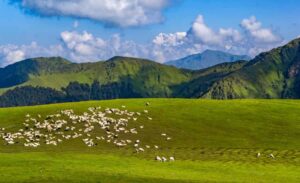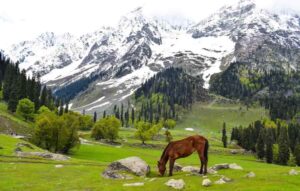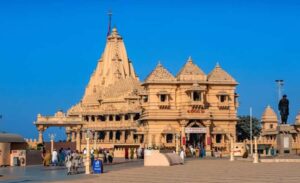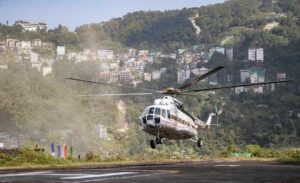Best Time To Visit Nubra Valley
Nubra Valley, often referred to as the “Orchard of Ladakh,” is a mesmerizing destination known for its unparalleled natural beauty. Located at an altitude of around 10,000 feet (3,048 meters) above sea level, Nubra Valley is famous for its lush green valleys, crystal-clear rivers, monasteries, and breathtaking sand dunes. The valley is flanked by the Karakoram Range and the Himalayas, making it a destination with diverse landscapes and climates. To make the most of your visit, you need to consider the weather, temperature, and seasons.

Spring (April to June)
Weather Conditions
Spring in Nubra Valley is a delightful season. The valley awakens from its winter slumber with the snow melting away, revealing vibrant landscapes. The weather is pleasant, and the days gradually become longer, allowing for more exploration. The skies are often clear, and you’ll be greeted with a colorful display of blossoming apricot and apple trees.
Temperature Ranges
Daytime temperatures range from 10°C to 20°C (50°F to 68°F), making it comfortably cool. However, nights can still be quite chilly, with temperatures dropping to around 5°C to 10°C (41°F to 50°F).
Pros and Cons
Pros:
- The blooming orchards create a picturesque landscape.
- Clear skies and pleasant weather make for excellent photography.
- Roads are mostly accessible, allowing you to explore the region more freely.
- The traditional Losar Festival is celebrated in April, offering a glimpse of local culture.
Cons:
- It can get crowded during the later part of spring, especially in June.
- Accommodation may be limited in the peak season, so early booking is advisable.
Activities and Festivals
Spring is a fantastic time for trekking, wildlife spotting, and enjoying the local culture. The Losar Festival, celebrated in April, is a wonderful opportunity to witness traditional Ladakhi music, dance, and rituals.
Summer (June to September)
Weather Conditions
Summer is the peak tourist season in Nubra Valley. The weather is warm and pleasant, and the entire region bursts into full bloom. This is when the valley is at its most vibrant, with green meadows and colorful flowers.
Temperature Ranges
Daytime temperatures can reach a comfortable 25°C to 30°C (77°F to 86°F), making it an ideal time for outdoor activities. Nights are relatively mild, with temperatures around 10°C to 15°C (50°F to 59°F).
Pros and Cons
Pros
- Ideal weather for exploring the valley and indulging in adventure activities.
- Maximum accessibility to the region’s attractions and monasteries.
- Availability of various cultural festivals and events, such as the Ladakh Festival in September.
Cons
- Crowds can be quite large, especially in July and August.
- Accommodation and transportation may be more expensive, and you should book well in advance.
Activities and Festivals
Summer is perfect for trekking, camping, river rafting, and attending local festivals. The Ladakh Festival in September showcases traditional dances, music, and arts from the region.
Autumn (September to November)
Weather Conditions
Autumn is a transitional period in Nubra Valley. As the summer ends, the weather becomes cooler and crisper. The landscapes take on a golden hue, and clear skies dominate.
Temperature Ranges
Daytime temperatures range from 10°C to 20°C (50°F to 68°F), while nights become progressively colder, dropping to 0°C to 5°C (32°F to 41°F).
Pros and Cons
Pros:
- The golden landscapes create a unique and enchanting atmosphere.
- Fewer tourists, making it a quieter and more peaceful experience.
- Great time for trekking and camping before the harsh winter sets in.
Cons:
- Limited accommodation and dining options as some facilities close for the winter.
- Early autumn (September) is preferable to late autumn for more pleasant weather.
Activities and Festivals
Autumn is a great time for trekking and photography. It’s a quieter season, which allows for a more intimate experience with the valley’s natural beauty.
Winter (November to March)
Weather Conditions
Winter in Nubra Valley is characterized by extreme cold and heavy snowfall. The valley is often cut off from the rest of Ladakh during this time, making it accessible only by the frozen Shyok River or the Khardung La pass.
Temperature Ranges
Daytime temperatures can plummet to as low as -10°C to -20°C (14°F to -4°F), and nighttime temperatures can drop even further, reaching -20°C to -30°C (-4°F to -22°F).
Pros and Cons
Pros:
- A unique and tranquil experience for those seeking solitude and serenity.
Opportunities for ice trekking, snow leopard spotting, and witnessing the winter life of locals.
Lower accommodation costs for those willing to brave the cold.
Cons:
- Extremely cold temperatures can be challenging to endure, especially for extended periods.
Most accommodations, restaurants, and tourist facilities are closed.
Activities and Festivals
Winter is ideal for adventurers who want to experience extreme cold and solitude. It’s also a rare opportunity to witness the lifestyle of the resilient locals who stay through the harsh winter months.
Best Time To Visit
The best time to visit Nubra Valley largely depends on your preferences and the kind of experience you seek. Here’s a brief summary:
- Spring (April to June): Ideal for those who want to witness the blooming orchards and enjoy pleasant weather. It’s suitable for trekkers and nature enthusiasts. The Losar Festival in April adds cultural charm.
- Summer (June to September): Perfect for all types of travelers. Summer offers the most activities, festivals, and a vibrant, lush landscape.
- Autumn (September to November): Suited for those who prefer a quieter experience and want to witness the golden hues of the valley. Ideal for trekkers and photographers.
- Winter (November to March): For adventurers who enjoy extreme cold and solitude. It’s an opportunity to experience a different side of Nubra Valley.
Conclusion
Nubra Valley is a destination that beckons travelers year-round, but choosing the best time to visit depends on your preferences and the type of experience you desire. Whether you want to witness the valley’s bloom in spring, the vibrancy of summer, the golden hues of autumn, or the extreme solitude of winter, Nubra Valley has something unique to offer in every season. Make your choice wisely, and you’ll be rewarded with an unforgettable journey through this Himalayan paradise.
Must Read:





